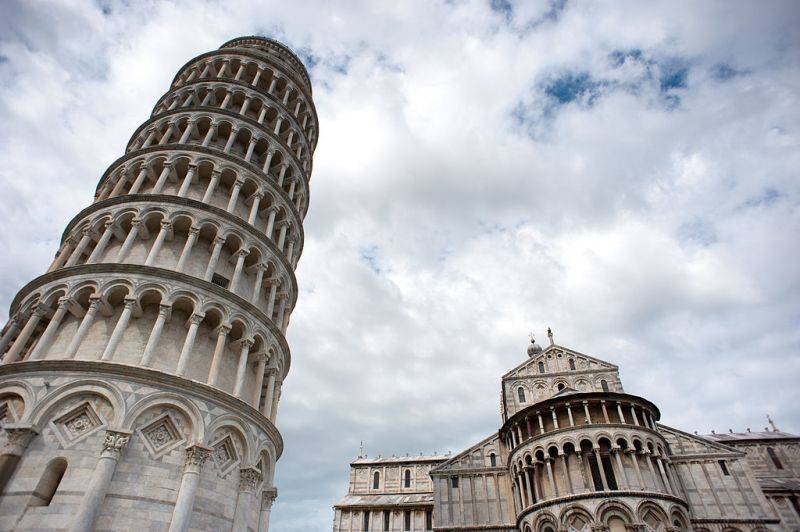Pisa Stands Tall, but Tremors Abound Elsewhere
ROME - The good news is that Italian geologists have successfully regrounded the beloved Leaning Tower in the Piazza dei Miracoli in Pisa. Two decades ago experts had serious reason to fear that the famous medieval tower was tending to lean farther and faster than in the past, to the point that it risked sudden and absolutely unpredictable collapse. By 1990 its inclination had reached 4.5 M (over 14 ft. 9 in.). At that point, according to engineer Giuseppe Bentivoglio, technical director of the team responsible for maintenance of the buildings in the piazza, "The tension to which the lower floors were subjected because of the thousands of tons of building, ever more outside their axis, made the possibility very real that it would all suddenly come down. When this happened to other historical towers there had never been forewarning."
The tower foundations were built atop less than solid ground that is moreover subject to water seepage. For this reason its construction took place in fits and starts. It began in 1173, was halted for nearly a century, began again, and was then blocked for another 80 years as its builders pondered what to do. In the end, after nearly three centuries had gone by, Tower construction was completed only by making the top floors tilt slightly in the opposite direction, so as to compensate for its already visible inclination. "This gave it the form of a banana," Bentivoglio told journalist Alex Saragosa in an interview for Il Venerdi Sept. 6.
In 1991 a 14-member International Committee for the Safeguard of the Pisa Tower was appointed under the direction of Michele Jamiolkowski, professor of Soil Mechanics at London's Imperial College of Science, Technology and Medicine. Using post-tensioned stainless steel bars and cables, the engineers put in placeda 900-ton counter-weight to tug the tower backward into position. For the next decade experts continued to analyze and to experiment with what other measures could best preserve the tower. Their conclusion was to extract, slowly and carefully, some 43 cubic meters of earth from between 12 and 21 feet beneath the stronger, northern section, "so as to provoke the subsidence of the earth to compensate for the subsidence on the opposite side," Bentivoglio explained.
This non-invasive technique worked. "Ever so gradually the Tower's inclination [was reduced] by something more than half a degree. Without touching the Towers, its present inclination is what it was in 1800," said a report presented by Jamiolkowski in collaboration with Carlo Viggiani of the University Federico II of Naples (now professor emeritus) and J.B. Burland, professor at Turin University and the Imperial College of London. Altogether the Tower has now regained 52.5 cm (almost 1 ft. 8.7 in.). Expectations are that it will over coming years remain stable, then begin slowly to list once more. "In the meantime it is safe for the next 200 years," said Bentivoglio.
But there is a second and larger problem facing this and other historic monuments in Italy. Those mini-quakes which make the quake-prone earth in Italy tremble are coming twice as frequently this year as in the past. Between June 21 and Sept. 4 the seismographs registered a record number of 7,116 mini-quakes. These "seismic movements," as these are properly called, are imperceptible to humans normally, but slowly do their damage, particularly to historic buildings. Claudio Chiarabba, who is the director of the earthquake division of the Italian National Institute for Geophysics and Vulcanology, says that, "The increase is substantial and means that if Italy had a median of 50 tremors a day, now we have double that number" (in fact, 200 daily). Most occur in the Tuscan-Emilian Appenine mountains, in the Irpinia region of the Campania, on the Tyrrenian coast of Calabria and in northeastern Sicily.
The causes behind the increase are uncertain. They could be natural--the release of gases from deep below the earth--or linked to man, like the drilling for gas (fracking) which is considered responsible for mini-quakes that have occurred in Texas, Oklahoma and Ohio. For this reason, experts here suggest that construction companies--instead of building new homes--invest their same financial resources and construction workers in improving the solidity and quake resistance of Italy's myriad historic buildings and town centers.


































i-Italy
Facebook
Google+
This work may not be reproduced, in whole or in part, without prior written permission.
Questo lavoro non può essere riprodotto, in tutto o in parte, senza permesso scritto.